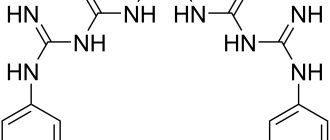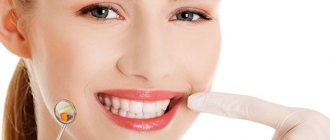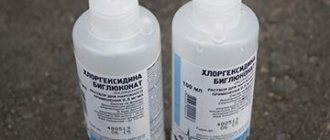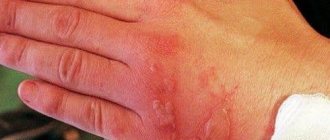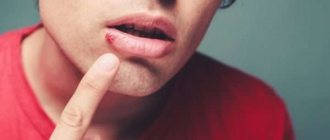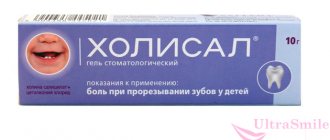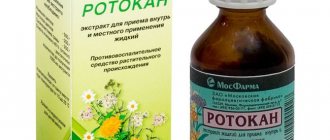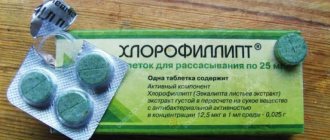Every expectant mother knows that it is better not to get sick while carrying a child, since the list of approved medications is very small. But Chlorhexidine during pregnancy is allowed to be used as an antiseptic for various dental, gynecological and otorhinolaryngological diseases.
Chlorhexidine can be used for treatment during pregnancy, since it is a drug that disrupts the structure of the microbial cell, destroying its membrane, due to which the death of pathogenic microflora occurs.
The solution has no effect on viral particles, so its use for infections of viral origin does not make sense, with the exception of herpetic lesions. Most often, Chlorhexidine is used during pregnancy to gargle and rinse the mouth.
Can Chlorhexidine be used during pregnancy?
The drug does not have a negative effect on the female body, and also does not penetrate the hematoplacental barrier, so the drug does not reach the baby. Therefore, the answer to the question whether it is possible to gargle with Chlorhexidine during pregnancy is obvious. Also, the substance does not pose a threat to the development of the embryo when used in the first trimester of gestation.
In addition to use for throat diseases, you can rinse the mouth with Chlorhexidine during pregnancy, and also use it for antiseptic treatment of the external genitalia.
Folk remedies and methods of prevention
Alternative traditional medicine can be a good solution to health problems, especially in the early stages of pregnancy.
- If you have a sore throat, you can rinse with a solution of honey and soda (1 teaspoon of honey and soda per glass of slightly warm water). Another option: rinsing with chamomile infusion (2 filter bags per 0.5 cups of boiling water, leave for 20 minutes). Frequency of treatment – 3 – 5 times a day until symptoms disappear.
- You can rinse your nose with regular table salt (1 teaspoon per glass of water). Herbs will have a good anti-edematous and anti-inflammatory effect: 2 tbsp. chamomile (calendula, sage) per 250 ml of boiling water. After insisting for half an hour, you can begin the procedure.
Chlorhexidine is a drug that can be used during pregnancy to treat diseases of the oral cavity and ENT organs, but with a caveat: only after consulting a doctor. Don't self-medicate!
Indications and contraindications
The medication is often prescribed for various gynecological diseases:
- vulvovaginitis caused by microbes sensitive to the drug;
- for STIs, such as gonorrhea, syphilis, trichomoniasis, mycoplasmosis, genital herpes;
Chlorhexidine is also used in pre- and postpartum vaginal treatment, when treating the hands of medical workers before obstetric examination.
Chlorhexidine digluconate is often prescribed during pregnancy to rinse the mouth for dental problems:
- For diseases of the oral mucosa, including stomatitis of various etiologies, herpes, erosion, and candidiasis.
- In pathological processes affecting the gums - periodontal disease, gingivitis of pregnant women, periodontitis. Used in complex treatment.
- As prescribed by a dental surgeon after tooth extraction and other dental surgical interventions.
Chlorhexidine is widely used in the treatment of:
- tonsillitis;
- pharyngitis;
- laryngitis;
- tonsillitis.
The therapeutic effectiveness of eliminating these pathologies is achieved only with an integrated approach to the treatment of throat diseases, so it is important to adhere to the doctor’s recommendations. Carrying out inhalations or rinsing with Chlorhexidine without taking other medications may not lead to recovery, and sometimes even worsen the patient’s condition.
The solution has high activity against microorganisms, so Chlorhexidine can be used during pregnancy to treat many infectious diseases.
Procedures with chlorhexidine
For inflammatory processes in the larynx, rinsing with Chlorhexidine solution is recommended. Before the procedure, it is necessary to perform preliminary oral hygiene:
- remove food fragments;
- brush your teeth;
- rinse with a decoction of chamomile flowers.
We suggest you read: How to treat stomatitis in children under one year old
After rinsing, you can eat after an hour and a half. In acute inflammatory processes, the procedure is performed every two to three hours. During the day, 3-5 rinses are allowed. Chlorhexidine has a slight bitter taste, which will be noticeable for some time after the solution remains in the oral cavity. This is considered an acceptable norm for the manifestation of its action.
It is advisable to complete treatment of caries at the dentist by sanitation of the oral cavity with a solution of Chlorhexidine. After tooth extraction, blood comes out at the operation site for some time. Rinsing with a solution of the drug or applying gel to the hole will speed up the healing process.
Instructions
Before you start using Chlorhexidine, you must carefully read the instructions, especially the section on use during pregnancy.
The annotation for the medication states that treatment with this drug while the baby is waiting is allowed only in situations where the risk to the mother exceeds the possible risk to the child.
Do not be afraid of such words, because this is a standard phrase warning that you need to consult a doctor regarding the advisability of using Chlorhexidine, and not self-medicate.
In addition, not a single drug is tested on pregnant women, so it is impossible to say with complete confidence about the absolute safety of the substance.
The most common liquid form of the drug, however, there are vaginal suppositories containing the substance chlorhexidine, which can be used during pregnancy to treat gynecological infectious and inflammatory diseases.
Instructions for use of Chlorhexidine:
- Oral baths for diseases of the oral cavity . Place 20 ml of Chlorhexidine in your mouth and hold for 30-60 seconds, then spit out the solution and do not rinse your mouth with water. It is important to observe the time the liquid remains in the mouth so that a protective membrane on the mucous membrane has time to form.
- Throat treatment . Before the procedure, rinse the oropharynx with water. Take a ready-made 0.05% solution of Chlorhexidine, do not dilute it with water, take a tablespoon of liquid and gargle thoroughly for a minute. After the manipulation, it is not recommended to eat for about an hour.
- Vaginal douching . To perform the hygienic procedure, a woman needs to sit in a bathtub or on a couch, insert the tip of the bottle into the vagina and irrigate it, and then try to hold the solution for several minutes.
Characteristic
Chlorhexidine belongs to the antiseptic group of drugs. Its main active ingredient is chlorhexidine bigluconate. It violates the integrity of the cell walls of pathogenic microorganisms and inhibits intracellular metabolic processes. As a result, the bacterial cells are destroyed and they die.
The mechanism of action of Chlorhexidine on a bacterial cell
Chlorhexidine destroys:
- most gram-positive and gram-negative microorganisms (staphylococci, streptococci, enterobacteria, ureaplasma),
- Trichomonas,
- gonococci,
- chlamydia,
- treponema,
- yeast fungi, dermatophytes,
- herpes and influenza A viruses.
Forms
There are several dosage forms of this antibacterial agent on the pharmacological market:
solution: water and alcohol. In the first form of the drug, the amount of active substance is from 0.05 to 20%. The concentration of Chlorhexidine in an alcohol solution is 0.5 or 0.8%. The antiseptic is sold in bottles. Their volume can be different: from 100 to 500 ml,- vaginal suppositories - packaged in blisters of 5 or 10 pieces. The amount of active component in one suppository is 16 or 18 mg,
- spray (0.5%) - sold in polyethylene bottles or spray bottles in a volume of 70 or 100 ml,
- gel. The concentration of the active substance in it is 0.5%. The product is placed in a tube in an amount of 15 or 30 g,
- cream – intended for external use. Contains 1% Chlorhexidine. The drug is packaged in a tube. Its weight is 50 g,
- emulsion (1%) – contained in glycerin. Sold in 200 ml bottles.
The choice of the dosage form of Chlorhexidine is made by the doctor depending on the diagnosis.
General indications
The use of Chlorhexidine is recommended in various fields of pharmacology. The use of an aqueous solution of the drug with a concentration of the active substance of 2% is relevant for:
the presence of cracks, abrasions, purulent wounds, burns on the skin,- inflammatory diseases of the oral cavity (stomatitis, alveolitis, gingivitis),
- the need to prevent the appearance of plaque on teeth and tartar,
- damage to the skin, mucous membranes by bacterial infection, fungi.
Alcohol and aqueous solutions of Chlorhexidine containing 0.5 and 1% of the active substance are used to disinfect cracks, burns and wounds on the skin, and treat medical instruments and equipment if they are not subjected to thermal sterilization. More concentrated forms of the drug are used to prepare other solutions of Chlorhexidine: glycerin, aqueous and alcohol.
The use of vaginal suppositories is recommended:
- for colpitis, bacterial vaginosis,
- before abortion, childbirth, installation of an intrauterine device (to prevent infectious complications),
- to prevent the occurrence of sexually transmitted diseases.
Vaginitis
The use of creams and gels based on Chlorhexidine is relevant for:
- wounds, diaper rash on the skin, pyoderma and impetigo,
- balanitis, vulvovaginitis,
- stomatitis, periodontitis, aphthae on the oral mucosa.
It is not recommended to use Chlorhexidine on your own, even if indicated. Like all drugs, this antiseptic has contraindications.
Improper use can lead to side effects and complications. A doctor must prescribe drug therapy.
Side effects
With long-term use of Chlorhexidine during pregnancy, there is a risk of developing negative manifestations:
- Temporary occurrence of enamel discolorations.
- Impaired taste perception due to the bitter taste of the drug.
- Dermatological reactions.
- Vaginal itching.
- The appearance of the symptom of “sticky palms”.
Cases of Chlorhexidine overdose do not occur in clinical practice, however, the solution should be used with caution by pregnant women who are hypersensitive to the active component due to the possible development of allergies.
Analogs
How can you gargle instead of Chlorhexidine during pregnancy? The pharmaceutical industry produces substances that can replace Chlorhexidine solution if it is not available in the pharmacy, and also if there are cases of hypersensitivity to the drug in the anamnesis, because during pregnancy you should not risk your health.
Analogs of this drug include:
- Miramistin.
- Furacilin.
- Rotokan.
- Chlorophyllipt.
- Pharmaseptic.
The listed medications have different active ingredients from Chlorhexidine. According to indications, they are used as antiseptics and anti-inflammatory medications.
It is not for nothing that Chlorhexidine is considered a universal remedy, since it has been widely used in many branches of medicine. For rinsing the mouth, rinsing the throat, and also for douching the genitals, Chlorhexidine during pregnancy is used only in the form of a low-concentrated aqueous solution.
Author: Violeta Kudryavtseva, doctor, especially for Mama66.ru
Properties of chlorhexidine
Chlorhexidine also has another name - bigluconate. It has antiseptic properties and acts at the local level, namely:
- Fights against germs.
- Destroys fungi.
- Effective against viral pathogens.
Moreover, the medicine is available in several forms - in the form of a patch, gel, alcohol solution, water-based solution, cream.
Stomatitis, as a rule, is treated with a liquid solution. In addition to its pronounced antiseptic effect, chlorhexidine for stomatitis also eliminates inflammation of ulcers, even if their number is large. In addition, chlorhexidine in gel form is indicated in the form of applications.
The drug has powerful protective characteristics - it forms a thin film on the mucous membrane, which protects the mucous membrane from germs, as a result of which treatment with the drug in the form of a solution significantly helps to get rid of inflammation in the form of ulcers.
The medicine has no contraindications for the treatment of children; its harmlessness has long been proven. Even if a child accidentally swallows the solution, it will not harm the baby if timely measures are taken to neutralize it.
Recommendation! Make sure that treatment with chlorhexidine does not last longer than 12 days, otherwise the baby will develop dysbiosis in the oral cavity - it will subsequently have to be treated.
Do not forget also that the drug does not help fight the herpes pathogen. It is impossible to completely treat herpetic stomatitis with the drug; chlorhexidine is effective only for simple inflammatory processes.
